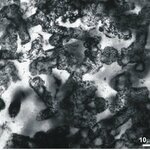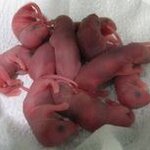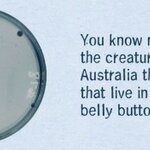Microbiology

The fossils of 3.4-billion-year-old microbes that used sulfur compounds for energy have been found in rocks from Western Australia, reports a paper published in Nature Geoscience.
David Wacey, Martin Brasier and colleagues analyzed microstructures present in rocks from the Strelley Pool Formation in Western Australia, and determined that they were the fossils of ancient microbes. The fossils were associated with tiny crystals of pyrite, a mineral composed of iron and sulfur. The isotopic composition of the sulfur suggests that the pyrite was formed as a by-product of cellular metabolism…

Thousands of tons of toxic mercury are released into the environment each year and much of it ends up in sediment where it is converted into toxic methyl mercury, - and then enters the food chain, including in the fish we eat.
New research in BMC Biotechnology details genetically engineered bacteria which can withstand high levels of mercury and go one step beyond - they can mop up mercury from their surroundings.
These genetically modified mercury-resistant bacteria, developed by researchers from Inter American University of Puerto Rico, Bayamon Campus, contained either the mouse gene…

Researchers searching for new ways to make hydrogen a viable part of our energy future have a new place to look; a natural example of a living hydrogen-powered 'fuel cell'.
During a recent expedition to hydrothermal vents in the deep sea, researchers from the Max Planck Institute of Marine Microbiology and the Cluster of Excellence MARUM discovered mussels that have their own on-board fuel cells in the form of symbiotic bacteria that use hydrogen as an energy source. Their results suggest that the ability to use hydrogen as a source of energy is widespread in hydrothermal vent symbioses.…

Creating sperm or egg cells in the laboratory has been tried several times in the past few years. The reasons for this range from a better understanding of the fundamentals of the reproductive process, to helping infertile couples with their child-wish. The attempts, using embryonic stem cells, however, did not yield viable germ cells.
Until now.
A research team at Kyoto University has succeeded in turning mouse embryonic stem cells into viable sperm precursor cells. The resulting sperm cells was subsequently used to give birth to healthy, normal cute little mice (see figure 1).
…

More bizarre news out of Florida. What do you think this
has in common with this?
If you answered, "they both look really disturbing," then I can't disagree. But the more pertinent answer is that both the cookiecutter shark (top) and the squid (bottom) have photophores. As explained in a University of Florida press release:
Like squid, cookiecutters are bioluminescent, producing their own light on parts of their bodies. Researchers believe the sharks may use this specialization to hide among squid while larger fish, such as tuna, prey on the squid. The sharks then surprise the larger fish,…

Our own body is covered with entire (albeit tiny) ecosystems. Incredible numbers of bacterial strains live in and on the human body. And the belly button seems to be a place extraordinarily rich in bacterial passengers. The Belly Button Biodiversity Project took samples from the navels of volunteers and went to work, performing DNA analysis on the bacteria that were found there.
(Source: Belly Button Biodiversity Project)
So far, 95 samples have been analyzed, and these have revealed an amazing diversity. Over 1400 bacterial strains have already been analyzed, of which 662 couldn’t even be…

Lasers (acronym for Light Amplification by Stimulated Emission of Radiation) were invented roughly half a century ago, and in that time, they have found their way to industry, medicine, all kinds of research, consumer electronics, and much more. Pervading modern day western society, several media can be used to generate lasers. But up until now, all these media were inanimate. Not any longer. Research published online on June 12th, 2011 in Nature Photonics (Gather and Yun, 2011) used a living cell to generate a laser (see figure 1).
Figure 1: Illustration of a single-celled laser. (Source…
While shopping earlier today, I came across these:
Many of you will, I expect, have heard of the recent E.Coli outbreak in Germany. Today, we learn from BBC news
German tests link bean sprouts to deadly E. coli
New data released in Germany strongly suggests that locally produced bean sprouts were, as suspected, the source of the deadly E. coli outbreak.
confirming suspicions already widely held. But how did the bug get there? The factory, it appears, follows stringent cleanliness procedures.
The lady is wearing full protective clothing, so that even her own…
Think you can't live without caffeine? Some bacteria can live on caffeine.
Previous studies discovered caffeine-degrading bacteria, but new research one goes a step further and identifies four bacteria that can live on the compound. One of them, known as Pseudomonas putida CBB5, was found in a flowerbed outside a University of Iowa research laboratory. Now they have identified the gene sequence that enables the bacterium to break down the caffeine compound in nature.
Caffeine is found naturally in more than 60 different plants and is composed of carbon,…

Preliminary data from DNA sequencing performed in cooperation with the University Hospital Muenster, Germany, on the Ion Personal Genome Machine (PGM) strongly suggests that the bacterium at the root of the deadly outbreak in Germany is a new hybrid type of pathogenic E. coli strains.
The data obtained from the DNA sequencer shows the presence of genes typically found in two different types of E. coli: enteroaggregative E. coli (EAEC) and enterohemorrhagic E. coli (EHEC). These results, which are being confirmed by further data analysis on the Ion PGM(TM), may provide insight into this…